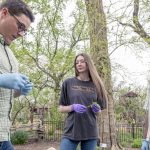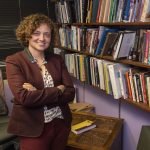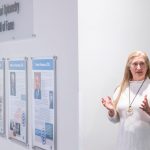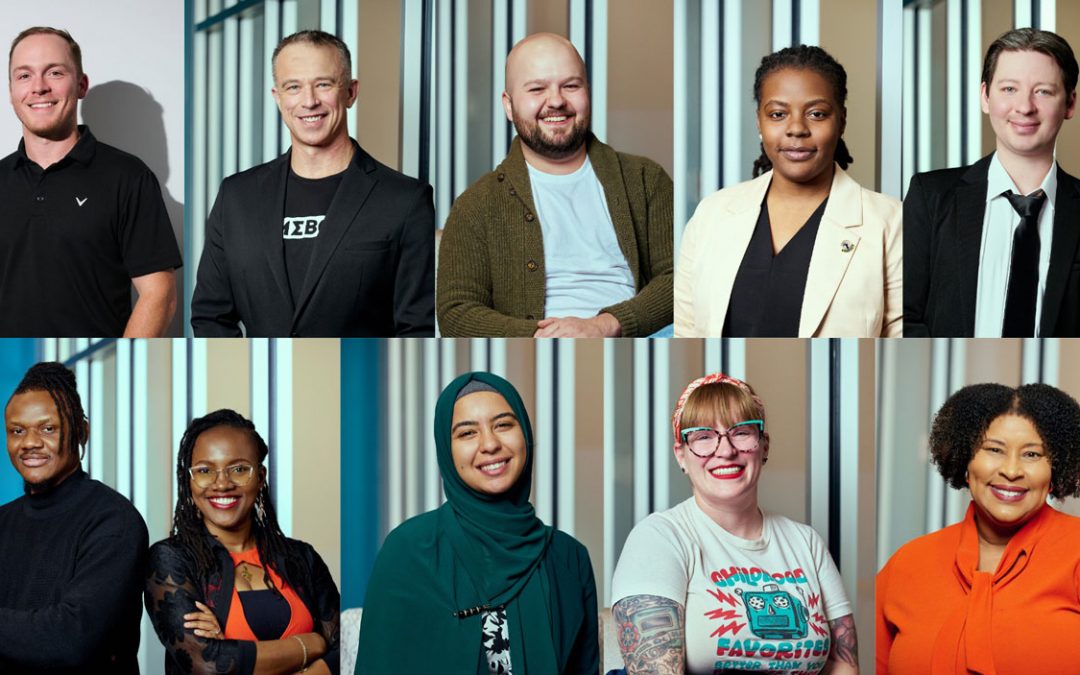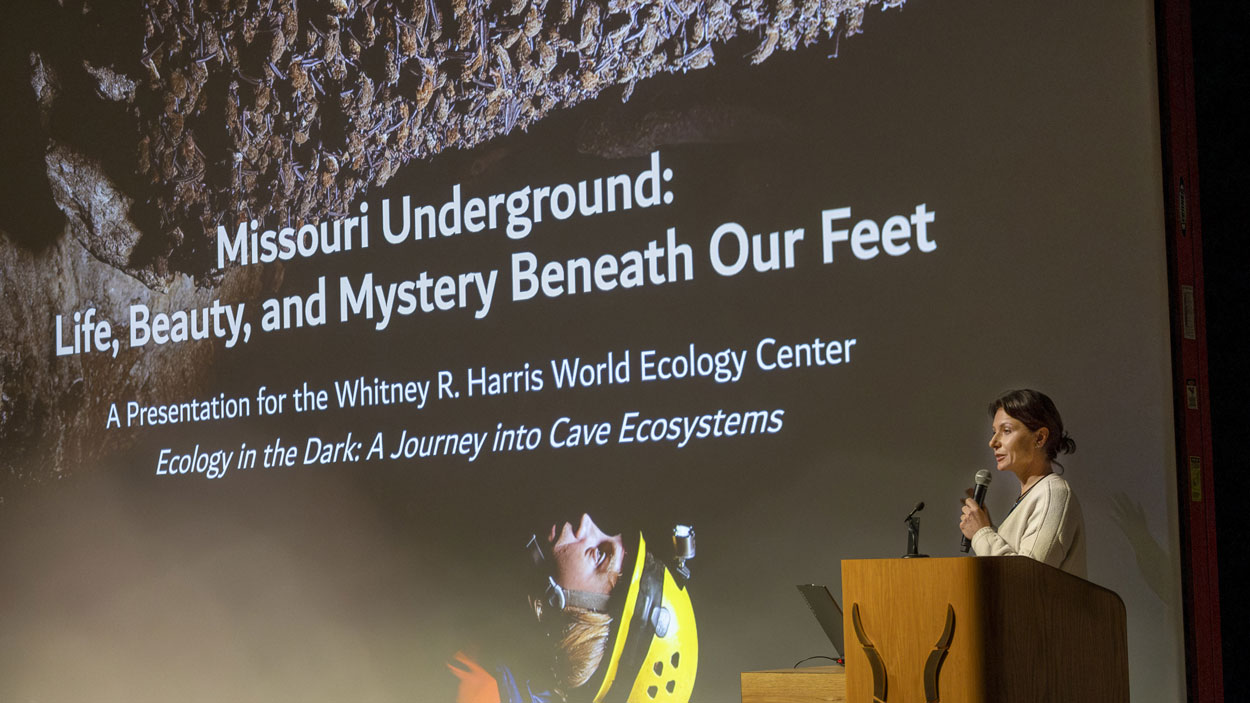
UMSL biology alum Vona Kuczynska, now a national recovery coordinator with the U.S. Fish and Wildlife Service, presents during last Tuesday’s Whitney and Anna Harris Conservation Forum, titled “Ecology in the Dark: A Journey into Cave Ecosystems.” (Photos by Derik Holtmann)
More than 7,500 caves can be found hidden throughout the landscape of Missouri, giving credibility to its nickname as the Cave State.
A trip to one of them – maybe Meramec Caverns, Onondaga Cave State Park or Fantastic Caverns – can be a rite of childhood for many Missouri residents, and memories of those visits remain sharp with the abundance of stunning photographs of illuminated rock formations captured inside.
But, of course, caves are more frequently characterized by darkness, and their often cramped corridors can hold tight to secrets about the biodiversity dwelling inside.
“We’re still really just scratching the surface of what’s actually found underground,” biologist Matthew Niemiller said last Tuesday evening while presenting to an audience of about 150 people during the annual Whitney and Anna Harris Conservation Forum.
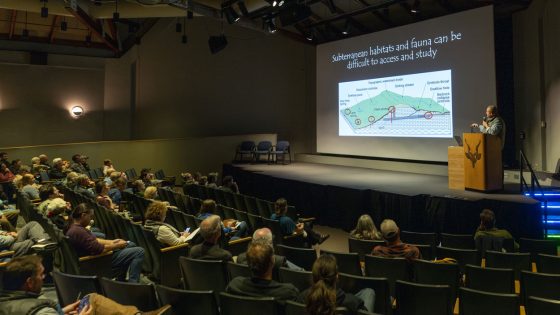
Matthew Niemiller, a biologist at The University of Alabama in Huntsville, discusses the challenges of studying animals living in cave environments, during the Whitney and Anna Harris Conservation Forum. About 150 people attended the 29th annual event last Tuesday.
The event, hosted by the Whitney R. Harris World Ecology Center at the University of Missouri–St. Louis, was created to provide an opportunity for the public to engage with leading experts in conservation and discuss critical environmental challenges. It marked its 29th year this year and aimed to shine a little bit of light on those mysterious cave ecosystems – in Missouri, across the country and around the globe.
Biologists Niemiller, Vona Kuczynska and Jut Wynne also provided attendees in the Anheuser-Busch Theater in The Living World at the Saint Louis Zoo with a rationale for why it’s so important to preserve and protect them as they took turns describing their work.
Their presentations were ordered in a way that built outward – from the research Kuczynska conducts on bats in Missouri as a biologist with the U.S. Fish and Wildlife Service to Niemiller’s work in the caves in Tennessee and other parts of the country as an associate professor at The University of Alabama in Huntsville, and finally to Wynne’s studies of cave wildlife around the world, including in Rapa Nui, Belize, Bhutan and China, as an assistant research professor at Northern Arizona University.
Kuczynska’s appearance was a homecoming of sorts. She is among the hundreds of UMSL biology graduates who received research support and funding from the Harris Center while pursuing her master’s in ecology, evolution and systematics, finishing her degree in 2015. She now serves as a national recovery coordinator focused primarily on strengthening the population of gray bats, as well as the cave-dwelling grotto sculpin fish, and keeping them from extinction.
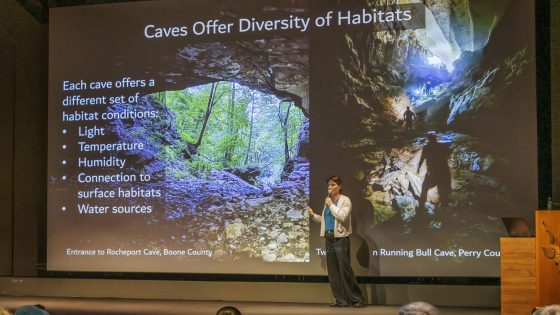
Vona Kuczynska’s presentation featured stunning images of caves around Missouri as she discussed their different habitats.
Before digging into a deeper discussion of her work, Kuczynska shared some basic information about caves, beginning with a simple definition.
“I would say it’s a widely disputed term,” she said, “but it’s basically a natural opening in the ground beyond the zone of light that allows for entry by at least a single person – and crawling counts.”
Though they can be formed in a variety of ways, in Missouri and elsewhere, they often occur in karst regions, which are formed by the dissolution of soluble bedrock, primarily limestone. A chemical reaction occurs when rainwater falling to the ground picks up carbon dioxide, either in the air or in topsoil, and becomes slightly acidic. It then enters cracks in the ground and, little by little, wears away at the rock to create caverns. When the water table changes, the caves are no longer filled with water and become more accessible to humans and other wildlife.
They provide a range of habitats based on the amount of light they have, the temperature, humidity, nutrients, water sources and access outside environments.
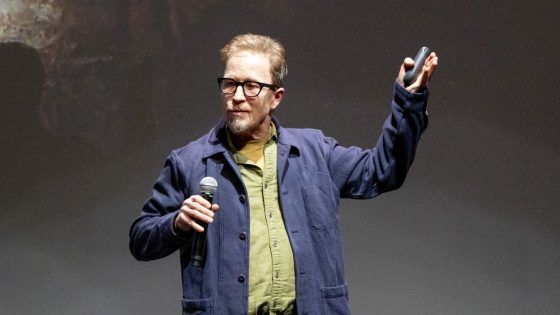
Jut Wynne, an assistant research professor at the University of Northern Arizona, was one of the presenters at the Whitney and Anna Harris Conservation Forum. He has studied cave ecosystems around the globe.
Niemiller’s research is focused on the numerous creatures – some as small as only two millimeters in diameter – that have come to call those places home. More specifically, he and his students work to understand the diversity, distribution and life history of different species as well as population genetics, phylogenetics and adaptions that occur as these organisms evolve. They also study human impact and examine which species are most important to prioritize in conservation and management efforts.
“To give you a summary of our current knowledge in terms of described biodiversity here in the U.S., we have about 1,460 species,” Niemiller said. “This is from a recent review that we put together, just published earlier this year. About 930 of those are terrestrial, and about 530 are aquatic.”
Niemiller showed off a variety of the species he’s encountered underground, but there are surely many more not yet described or known to science because of the challenges of working in cave environments and the relatively small amount of research funding that has been directed to study subterranean creatures, particularly in the United States.
He described how his students have used environmental DNA to complement their other work and uncover evidence of different organisms.

Aimee Dunlap, a professor of biology and the director of the Whitney R. Harris World Ecology Center, welcomes attendees to last Tuesday’s conservation forum.
“We collect water samples,” Niemiller said. “We sequence them – basically, filter them and extract them, and we develop an assay for a single species. What we’re trying to move towards is being able to characterize entire communities right from that water sample. So, conducting analysis using bioinformatics to get these multispecies identifications.”
Wynne has worked in some of the most remote and previously unexplored places on the planet over the past two decades, and his research, specializing in invertebrates, has contributed to the discovery of numerous species that were new to science.
He noted that very few of these sensitive cave habitats are part of protected areas, and climate change looms as a growing threat.
Wynne has developed a novel “all-taxa” approach for studying caves that involves ecosystem-level sampling of fauna, including systematic sampling of invertebrates and bat sampling using mist-netting and hibernacula counts.
“We’re looking at two different types of caves,” Wynne said. “We’re looking at caves that have not been sampled yet, so we were establishing baselines for these caves, both by mist-needing bats and acoustic detection, but we’re also going back to sites that were sampled over 10 years ago and resampling those areas, and that way we can compare the historic data to the contemporary data to see if there are any changes in population structure over time.”
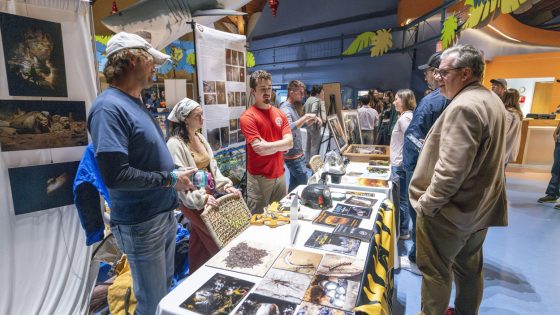
Members of Meramec Valley Grotto and Southeast Missouri grotto speak with guests about caves and cave conservation at the Whitney and Anna Harris Conservation Forum. Local caving organizations were well-represented at last Tuesday’s event in The Living World at the Saint Louis Zoo. UMSL graduate students also gave poster presentations of their research in the building’s rotunda.
Wynne, who has worked all around the globe, also discussed the importance of learning from local populations and their innate expertise when studying caves and integrating cultural values into conservation efforts.
The conservation forum drew enthusiastic attendance from members of the robust caver community in Missouri and Illinois.
Among those present was Dan Lamping, an UMSL alum and social studies teacher at Mehlville High School, who serves as the president of the Missouri Speleological Survey and co-manager for the Cave Research Foundation’s Ozark Operation Area. He enjoyed the presentations and appreciated the opportunity to bring biologists and amateur cavers together because of the valuable insights they can offer each other.
“Speleology has always been this combination of amateurs and academics and professionals,” Lamping said. “In some regards, it hasn’t gone through the same professionalization processes that other disciplines have. You have cave biologists that are very nuanced and specific in terms of what they’re doing, but I have no formal training in anything specific to caves. In regard to Missouri caves, though, I would be an expert on them. So, it’s kind of unique that potential is still there for people to pick up skill sets and learn things outside of an academic setting.”





